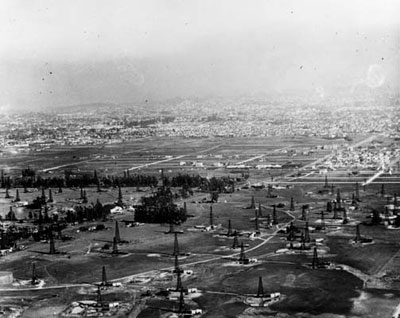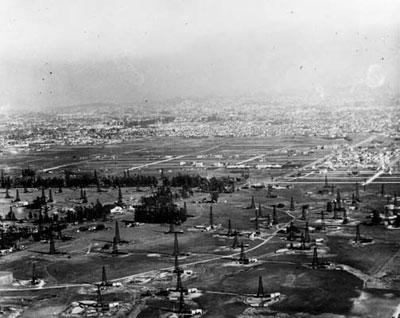
Oilfields at Wilshire and Fairfax, 1920s
It's easy to think of L.A. as a city fixated on the new. When we talk about history in L.A., conversation tends to revolve around which star once lived where; when I first moved to this city a realtor tried to sell me on a rundown apartment building that Bette Davis supposedly once lived in—"now a writer for the Gilmore Girls lives here!" It's a similar kind of conversation New Yorkers have about storefronts ("that shoe store used to be a butcher shop..."). It's a kind of cultural or architectural oral history of a city's neighborhoods.
There was an interesting post over at BLDGBLOG last week, on the lost airfields of Los Angeles (something we've touched on here as well). Using the historical photos archived by UCLA's Re-Mapping Los Angeles project as his jumping-off point, Geoff Manaugh, the blog's proprietor, dreams of an "archaeology of airfields" that "could be inaugurated at the corner of Wilshire and Fairfax, where a group of students from UCLA will brush aside modern concrete and gravel to find fading marks of airplanes that touched down 90 years ago, over-loaded with film equipment."
The truth is that the history of the landscape at Wilshire and Fairfax is far more layered than prehistoric wooly mammoth and twentieth-century stunt pilots. The excellent site Curating the City includes a timeline of Wilshire Boulevard stretching back to 500 AD, when Tongva Indians settled in what is now known as Brentwood. To build their settlement, they would trek to the tar pits to use the tar for building materials. Twelve hundred years later Spanish explorers followed these same paths from the tar pits to the ocean. Think about that next time you're trapped in gridlock at Wilshire and Westwood.
In 1903, a man by the name of Arthur Gilmore struck oil at Wilshire and Fairfax. In 1908 he opened the first gas station in the city—a gas tank perched on a wagon he parked on the corner of what was then a dirt road. By 1934 that dirt road was the city's first major paved artery, linking the ocean and downtown). You might say L.A.'s car culture was born on Wilshire—and it gassed up at Fairfax. (Fitting, then, that the Petersen Automotive Museum is also on this intersection.)
Gilmore's son, Earl, did his share of developing land in the area too. He built a football stadium at Fairfax and Beverly, and in 1934 offered to let a handful of farmers sell their crops in a makeshift market nearby. The stadium is gone from the site today, now occupied by CBS Studios. The Farmers Market, of course, is still there. So is the Apple Store.



